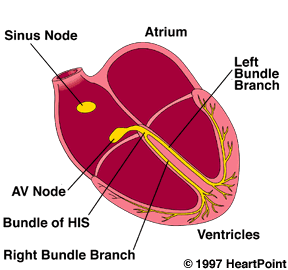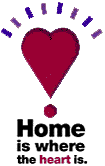GENERAL ARRHYTHMIAS

What are the
symptoms of arrhythmias?
How do I tell what
kind of arrhythmia is occurring?
Some general causes
of arrhythmias and palpitation?
Is there anything
I can do to make palpitations better?
When should I worry
about palpitations?
What are the
symptoms of arrhythmias?
There may be no symptoms at all. At
other times, a very slow rhythm may cause the patient to become lightheaded
or to pass out ("syncope"). There is more about this later in
this section. Patients may experience symptoms of congestive heart failure
with shortness of breath, swelling of the ankles, and other symptoms. In
the case of a very rapid rhythm, the same symptoms may occur because at
high rates, the pumping chambers don't have the chance to fill adequately.
By far the most common symptom of arrhythmias
is "palpitations", the awareness of the heartbeat. Under some
circumstances, people are aware of their heart beat when it is beating normally.
It can often be felt when the electrical system is working just fine, but
the heart muscle is simply beating hard enough to be felt in the chest,
upper abdomen or other areas. Interestingly, it is not entirely uncommon
for rumblings from the stomach or twitches from muscles in the chest wall
to be misinterpreted as coming from the heart.
Palpitations coming from irregular rhythms
are often described in several ways:
- "A skip" is the sensation
people often report when a beat occurs early. There is little time for
filling, and little blood is ejected from the heart.
- A "pause" or "it stops!"
is also a frequent description. The mechanism is often exactly the same
as for the skip. In this case however, the patient is aware of the pause
rather than the early beat. This often is accompanied by a resounding "thump"
when the next beat occurs, a result of extra blood being ejected which
had filled the heart chamber during the pause.
- Multiple skips can also occur, which
may be regular or irregular in their rhythm.
It is virtually impossible to make a
specific diagnosis of the mechanism of an arrhythmia from the type of palpitations
it produces. Even more confusing sometimes is the fact that a patient may
be having more than one type of arrhythmia, and it all feels pretty much
the same to them.
How do I tell what kind of arrhythmia
is occurring?
Most of the time you can't tell on your
own. The electrocardiogram will tell the story, and be able to show the
electrical mechanism of the arrhythmia. Of course, the arrhythmia has to
occur during the time the ECG is being recorded to evaluate it. Trouble
is, just like your car at the mechanic's, you can't always get that arrhythmia
to perform "on cue". For this reason, there are several devices
which are used to try and catch the culprit:
- Holter monitors have been in use for
many years. Several leads are placed on the chest and connected to the
device which is worn on the belt which will record every single beat that
occurs while it is on. The results are "scanned", nowadays usually
with the aid of a computer under a technician's guidance, and printed on
paper for review. The advantage of this technique is that every beat is
recorded, even irregular rhythms that the patient is not aware of. The
disadvantage is that the device is typically only worn for 24 to usually
no more than 48 hours. Many patients will not have their symptoms during
the recording.
- "Heart cards" are credit
card-sized devices which can be carried around with the patient, but don't
require leads to be hooked up. Recordings can be made simply by placing
the device on the bare skin of the chest - the recording electrodes are
on the little card itself. A button is pushed, and the heartbeat occurring
at that time is recorded. A phone number is then called, the device placed
over the speaker of the phone, and another button is pushed. This sends
a sound out over the telephone line, which is then translated on the other
end into an electrocardiographic recording. These are great devices for
people who have symptoms that last a little while (long enough to get the
device out and press the button).
- "Event monitors" have similarities
to both holter monitors and heart cards. For these devices, leads are worn
most all of the time. In this case, heartbeats are continuously recorded,
although there is only room for about 5 minutes worth. The beats which
occurred over 5 minutes are "lost" or "forgotten" to
make room for the new beats. When an event occurs, the button is pushed
at the first available moment. This can be very valuable for people who
have very brief symptoms, or those who experience a loss or diminution
of consciousness for whom the heart card would not be useful (since the
arrhythmia probably would have passed by the time they were able to place
the heart card on the chest).
Electrophysiologic studies (EPS) is
another form of testing which can be utilized in certain circumstances where
the results of the above tests are unrevealing. These studies are performed
in the hospital. Patients are brought to a suite similar to a heart cath
lab. Catheters are inserted in veins and/or arteries and advanced to the
heart where very precise recordings of the electrical activity can be obtained.
In some cases, catheters are also used to stimulate the electrical system
to see if abnormal beats can be "induced".
What are some general causes of arrhythmias
and palpitations?
- They may not be associated with any
significant abnormality
- Stress is not an uncommon associated
condition. This may be subtle and overlooked. Sometimes however, patients
with serious arrhythmias convince themselves "it's just stress"
when in fact there is in fact another more important condition.
- Lack of sleep.
- It is very common for stimulants to
cause palpitations, even those stimulants which are socially acceptable
such as caffeine which is found in coffee, tea (hot or iced), and many
carbonated beverages. Caffeine is also found in over-the-counter medications
including some pain relievers and agents sold to prevent drowsiness.
- Nicotine and other stimulants and
toxins in cigarettes, cigars, snuff and other tobacco products.
- Chocolate contains significant amounts
of stimulants.
- Alcohol can be associated with palpitations
and arrhythmias, some of them serious.
- Over the counter medications, particularly
those containing "decongestants".
- Medical conditions such as increased
thyroid.
- Abnormalities of electrolytes, such
as potassium or magnesium which are more common if a person is taking medicines
such as diuretics (water pills).
- Some medications
- Essentially any heart condition
Is there anything
I can do to make palpitations better?
See your physician if they are persistent
or accompanied by other symptoms as noted below. Regardless of the cause,
there are certain things you can do that will make a difference.
- Good "health hygiene" is
important. Address stress, get enough sleep, follow a good exercise program
(as outlined by your physician).
- Avoid the stimulants noted above.
- Examine any over-the-counter medications
you may be taking.
- Keep track of your symptoms . . .
see if you can find a pattern.
- Don't self-diagnose.
When should I worry about palpitations?
Palpitations are very common in the
general population. They are also generally "benign", and do not
require specific investigations or therapy if they are infrequent and not
associated with any other symptoms.
Certain other things should lead you
to consider further evaluation:
- If you suffer lightheadedness or pass
out in association with palpitations, this implies that you are not providing
enough output from your heart. This should definitely be evaluated.
- Likewise, if you suffer shortness
of breath or if you have pains in your chest, neck, shoulders, arms or
back in association with the palpitations.
- If these occur with the initiation
of a new medication.
- If palpitations occur with other symptoms,
such as significant weight loss, or you are otherwise feeling ill over
a period of time.
- Are accompanied by headaches and sweating.
For more about Arrhythmias, also see these related subjects
on HeartPoint:
©1997 HeartPoint Updated October 1997


 | Commentary
| Food You Will Love | HeartPoint Gallery | In
The News | Health Tips
| What's New
| Commentary
| Food You Will Love | HeartPoint Gallery | In
The News | Health Tips
| What's New
| Information Center | Home |


